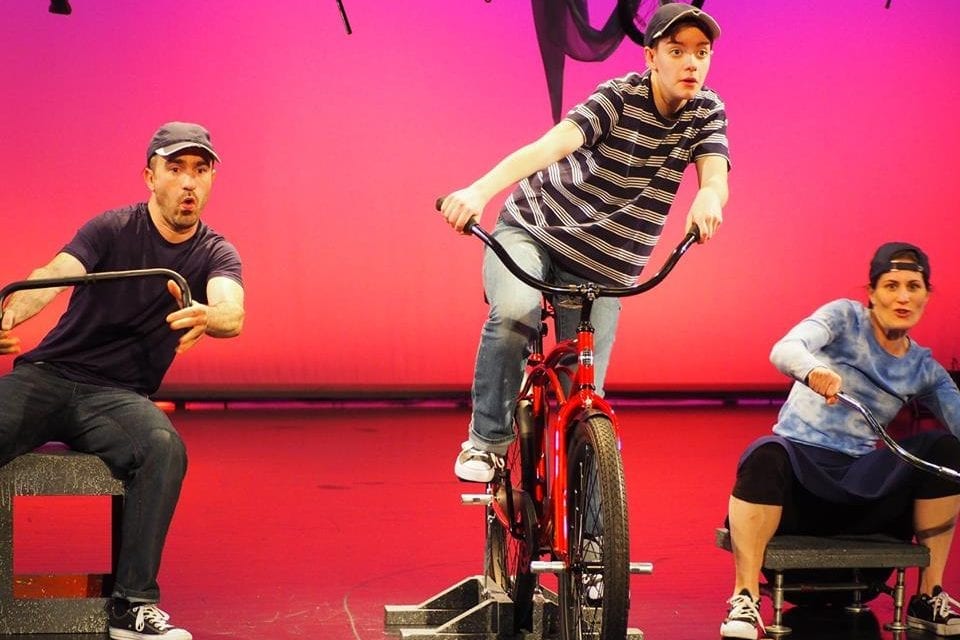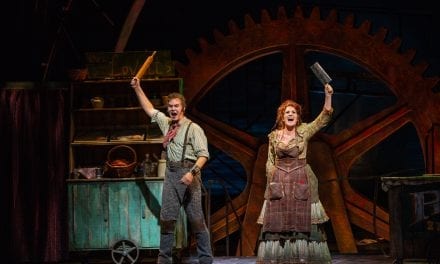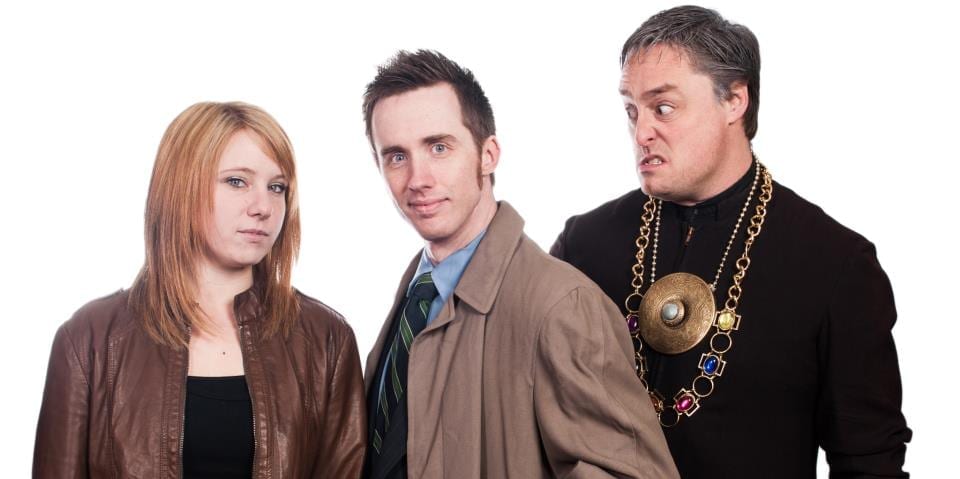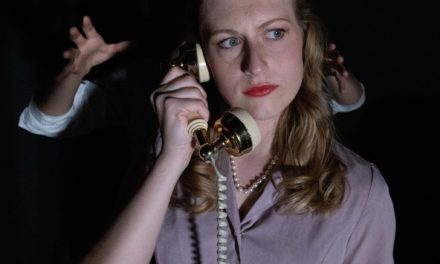SALT LAKE CITY — Red Bike, produced by Pygmalion Theatre Company, is a thought provoking play written by Caridad Svich. The play is often mesmerizing with its repetitive phrases like, “Stocks, derivatives, and securities,” hinting at a need for social change. This show is best suited for adults.

Show closes May 5, 2018.
Red Bike is about a child about 11, who is played by all three actors in the cast. The child has acquired a red bike, and the play follows not only their thoughts about the dying town they are in, but also as they take on a big hill and speeds out of control on the way down, ending in an epic crash. The thoughts shared include judgments on old people in the town, the kid’s parents, and the man who “owns” half the town and how he uses his wealth. The downhill ride lasted about half the play with memories and thoughts breaking it up, and I felt it was a rather tedious way to speed down a hill. And that ride didn’t include their life flashing before their eyes.
This performance was directed by Fran Pruyn, who took advantage of the script’s allowance of creative liberties and interpretations. For example, Svich wrote the script to allow one to three actors to play the gender-neutral main character, and Pruyn chose to cast three people. I liked having that dynamic because the play is 75 minutes long with no intermission, and with three actors it helped to keep my attention. One of the directing choices was to add percussion in the form of drumming on boxes, short tunes from a single trumpet, and the clicking of a bikes wheel turning. This gave a nice depth to the show by alerting my auditory senses throughout the evening. However, at times I felt like there was too much to take in. The script jumped around in its action, which inhibited understanding.
 I also appreciated the way Pruyn had the characters so comfortable with each other and the environment. The closeness allowed me to see them as one person in some cases and to also see their deep feelings for things like the red bike.
I also appreciated the way Pruyn had the characters so comfortable with each other and the environment. The closeness allowed me to see them as one person in some cases and to also see their deep feelings for things like the red bike.
Sydney Shoell played the child most often while the other two actors, Jesse Nepivoda and Andrea Kile Peterson, would play her parents, an old man, the business owner, and others. The actors used great vocal inflections and moments of stark silence to keep the script lively. One example is when they would stop and stare at the sky, and then talk about drones watching them. Another is when Shoell would look at the business man who owns half the town, played by Nepivoda, and chant, “Red Bike, red bike, red bike,” louder and louder. It felt eerie and futuristic. Nepivoda changed characters quickly and was believable. He would change his posture and deepen his voice for older characters. Shoell brought out the true experience of an 11-year-old while playing a superhero and saying, “I’m like a cartoon!” Peterson got me laughing as she acted out all the things the child wanted to be when she grew up, including a helicopter.
The performance, though full of enjoyable acting, sounds, and energy, was hard for me to follow because it had a lot of little scenes that didn’t seem to interrelate to provide a reason why for this play. I got a few little reasons, like the pain of losing the dollar store, hope of getting into the Tour de France, and parents hiding their feelings, but I wasn’t moved by these vignettes very deeply. The script seemed to be full of complaints about life, with very few lines provoking change or deep pain. I wanted to have a moment or two of catharsis and really cry from seeing this show, or at least have a great learning experience. Instead, I was confused because it jumped around and didn’t seem to provide the point of it all. It would probably be more direct, clear, and powerful if 15 minutes were cut out.
The set, designed by Thomas George, was minimal and incorporated bike pieces hung on clothes lines across the back of the stage. It looked messy and broken, and it effectively reflected the play itself. George provided plain wooden boxes that were easy for the characters to manipulate in their set changes. Front and center was a beautiful red bike that stood out from the gray and black of the set pieces.
When I’ve seen shows like this before there has been some sort of explanation at the end, like “this was actually about a child growing in the womb” or “the main character was dead,” and my mind would be blown. I was waiting for that moment with this play, but no luck. I would have understood such an abstract play better with an explanation like that. I stayed for the after show discussion, and it was helpful by sharing some of Svich’s childhood and where she got some ideas for the show, as well as the freedoms taken by the performers. But the talkback was not enlightening to the point that I felt I could understand and appreciate the play. However, because there was so much to take in, I am still thinking about it. Maybe the insight I seek will come eventually.
Donate to Utah Theatre Bloggers Association today and help support theatre criticism in Utah. Our staff work hard to be an independent voice in our arts community. Currently, our goal is to pay our reviewers and editors. UTBA is a non-profit organization, and your donation is fully tax deductible.





